Categories
Latest Updates
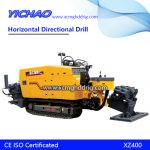
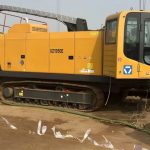
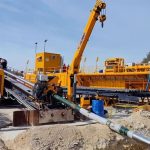
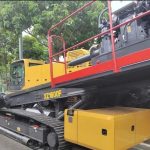
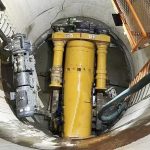
Modern trenchless construction technology originated in Japan, the United Kingdom and the United States in the late 1960s. Due to its technical advantages, it has been widely promoted all over the world. In 1986, the International Association for Trenchless Technology (ISTT) was established in London. -International Society for Trenchless technology). Trenchless construction techniques mainly include horizontal directional drilling construction and pneumatic hammer construction, and the two construction methods have a tendency to be combined. The pneumatic hammer construction method can be divided into technologies such as pneumatic spear drilling, ramming pipe method, and broken pipe method.
Trenchless construction technology is a construction method for laying, replacing and repairing underground pipelines without excavating the surface. Compared with traditional excavation methods, it has no impact on traffic, no damage to surface facilities, and construction period. Short, low construction cost, convenient operation, significant social benefits, etc., especially for situations that need to be deep underground, there are obstacles on the surface, and ground attachments are difficult to repair. At present, it is widely used in crossing roads, railways, Buildings, rivers, and pipelines for municipal administration, water supply, gas, electricity, telecommunications, oil, natural gas, etc., are laid, updated and repaired in urban areas and historical sites.
Due to the earlier research on trenchless construction technology abroad, a variety of products have been formed. Representative manufacturers include Vermeer, DitchWitch, and Mchlaughlin in the United States, MTM and POWERMOLE in the United Kingdom, and ESSIG in Germany. And TRACTO-TECHNIK company and Terra company of Switzerland.
The development and research of trenchless construction technology and equipment in China started relatively late. In the late 1980s, due to the increasing number of projects that did not allow the excavation and laying of underground pipelines, and the development of major cities’ reconstruction and expansion projects, they began Introduced various types of trenchless construction equipment, promoted the development and research of China’s trenchless construction technology and equipment, and established the China Trenchless Technology Association. The development of trenchless technology in China is very rapid. In 2004, the output value of trenchless engineering and the input of equipment reached a growth rate of 40-50%. The domestic rate of equipment has increased significantly, and the localization rate of some equipment has reached 90%, the annual output value exceeds 3 billion yuan.
The construction method of horizontal directional drilling pipe laying is as follows: using a horizontal directional drilling machine, first drill a smaller pilot hole, then remove the pilot bit, replace the reaming bit for reverse reaming, and at the same time pull the pipeline to be laid into the drill Depending on the capacity of the drilling rig and the diameter of the pipeline to be laid in the hole, it is sometimes necessary to ream the hole twice or more before laying the pipeline. The construction method is as shown in the figure below.

The left side of the figure is a schematic diagram of horizontal directional drilling for pilot hole drilling, and the right side of the figure is a schematic diagram of reaming and laying pipelines. Horizontal directional drilling has a controllable drilling system that can perform directional drilling. Through the rotation of the drill rod and a specially designed wedge drill bit, the directional drilling process can be controlled in three dimensions. The principle is: when the drilling process needs to change the direction, the drill rod stops rotating, and the wedge surface of the wedge drill bit is fixed to the corresponding The drilling direction can be changed by pushing the drill rod forward. Important data such as the position of the drill bit, the inclination of the drill bit and the ground, and the angle of the wedge surface are transmitted to the receiving instrument on the ground through an electromagnetic detector. The wedge-shaped drill bit that reaches the target point will be replaced with a conical reamer. When the drill rod is pulled back, the hole will be expanded to the required diameter and the pipeline will be brought in. The reamer bit is shown in the figure below, which can achieve rock and soil quality. Reaming the formation.
Directional drilling rigs are classified into 6.5t, 10t, 12t, 20t, 20t, 150t according to different pushing and pulling forces. They can be used for pipelines with a diameter of 600mm and a pipeline laying length of 350mm or several kilometers. In order to meet the pipeline laying requirements of larger pipe diameters and longer distances, some companies are studying larger tonnage directional drills.
The directional drilling rig is suitable for the construction of homogeneous layers. When drilling into gravel formations, it is difficult for general drilling rigs to construct. In order to solve the above-mentioned construction problems, the German company TRACTO-TECHNIK has developed a drilling rig with percussive function, which can crush the gravel in the drilling, and return to the When large pebbles are encountered during expansion, the rock reaming bit on the right in Figure 2 can be used.
At present, there are many mature methods for drilling in rock. Among them, the KSD25 wet and dry horizontal directional drilling rig developed by Zoomlion uses pneumatic percussion hammer drilling technology to complete hard rock pilot hole drilling. . However, there is still no new method for reaming in the rock, and traditional cone drilling tools are still used, which are low in efficiency, severely worn, and high in cost.
With the upgrading of products, horizontal directional drilling rigs are developing in the direction of intelligence, which can realize functions such as intelligent drilling correction, intelligent fault diagnosis, automatic loading and unloading of drill pipes, automatic anchoring, automatic mud cleaning and automatic drilling.
The structure of the pneumatic impact hammer is very simple. It consists of a piston cylinder, a piston moving in the piston cylinder, and no more than 10 auxiliary parts. Its working principle is: the impact piston is driven by compressed air and hits the front end of the piston cylinder. The reaction force of the front end on the piston makes the entire impact hammer move forward in the impact direction in the soil layer. Pneumatic spear (HammerHead Mole), pipe ramming hammer (Pipe Ramming Systems) and pipe breaking hammer (Pipe Bursting Systems) are all called pneumatic impact hammers. The construction methods of the three pneumatic impact hammers will be analyzed below.
1. Pneumatic spear
The construction method of the pneumatic spear is: under the action of compressed air, the piston in the pneumatic spear makes a reciprocating motion, continuously impacting the spear head, the spear head squeezes the surrounding soil to form a hole, and drives the spear body to advance in the soil; As the pneumatic spear advances, the pneumatic spear drags the pipeline with a small diameter into the hole to complete the pipeline laying. According to different geological conditions, a pneumatic spear can be used to form the hole first, and then the pipeline can be dragged into the hole, or the pipeline can be dragged into the hole while drilling.
The pneumatic spear is suitable for laying steel pipes, PE, PVC, cables and other pipelines with an outer diameter of 30~150mm and a length of 10~100m in a homogeneous layer without water, such as clay and loam. The pneumatic spear has the advantages of simple operation, convenient assembly and disassembly, easy maintenance, low construction cost, fast construction speed, etc., and has the function of forward and reverse movement direction.
The diameter of the pneumatic spear is 45~180mm, and the impact force is 1.7~43 tons. With the addition of accessories, the pneumatic spear is also suitable for ramming in the vertical direction such as foundation piles. It can also be used when equipped with a sleeve cone. Tamper use.
Generally, pneumatic spears can only achieve linear drilling, but the directional pneumatic spear developed by TRACTO-TECHNIK in Germany can also achieve directional drilling. The construction method is shown in the figure below. The direction of the directional pneumatic spear is guided by a standard guide. The sensor is placed in the front chamber of the pneumatic spear to provide inclination and rotation information to the display. The manual positioning device on the ground can accurately track the inclination and depth position of the pneumatic spear. According to the different structure of the soil, the minimum bending radius of the directional pneumatic spear is 27-30 meters.

2. Tube rammer
The pipe rammer construction method is to use a pipe rammer to directly ram the steel pipe to be laid into the ground along the designed route. During construction, the impact force of the rammer directly acts on the back end of the ram tube, and is transmitted to the front end of the tube through the steel pipe for cutting. The soil layer, and overcome the friction between the steel pipe and the ground, make the steel pipe continue to enter the soil layer, and realize the trenchless laying of pipelines.
The pipe tamping hammer is connected with the ramming pipe by a pipe-protecting chuck, and the tapered steel sleeve of the pipe-protecting chuck can effectively fix the tamping hammer on the ramming pipe, so that no support frame is needed. With the retreat function of the pipe rammer, the pipe rammer can be easily taken out from the pipe protection chuck. The construction method of the rammer is shown in the figure below.

The left side of the figure above shows the pipe rammer firmly connected to the ram tube with the pipe protection clamp and placed on the ram tube support platform. The impact load of the ram tube hammer rammed the tube into the ground. The right side of the above picture shows the situation where compressed air or high-pressure water is used to push the pressure plate to push the soil and rock out of the pipe. The auger can also be used to dig out the soil and rock in the pipe.
The tamping hammer has a diameter of 95-600 mm and a tamping force of 23-2000 tons. It is suitable for laying steel pipes with an outer diameter of 50-3500 mm and a length of 10-80 m in various soil layers without large gravel. The pipe rammer construction method has the advantages of no need for expensive resistance supports, short installation and adjustment time, simple technology, small construction depth, low construction cost, and fast construction speed, and it also has the function of retreat.
The pipe rammer uses dynamic impact energy to ram steel pipes into the ground. The pipe rammer tends to deviate from the direction when the stratum changes or encounters obstacles. The direction of drilling is uncontrollable, and the track accuracy is low. It is not suitable for large-scale gravel formations. use.
3. Pipe Breaker
The pneumatic pipe breaking hammer construction method is to burst the original old pipeline with a pipe breaking hammer and re-lay the new pipeline. The newly laid pipeline can be equal to or larger than the original old pipeline. The construction principle diagram is as follows.
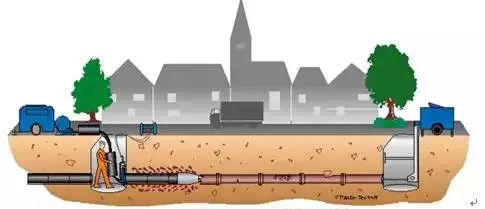
When the pipeline has longitudinal cracks, leakage, product deposition, blockage, etc., the broken pipe method can be used to re-lay the pipeline, which is a quick and economic construction method. The broken pipes are updated with old pipes made of ceramic, unreinforced concrete, asbestos cement, plastic or cast iron.
The pneumatic pipe breaker has a diameter of 130~600 mm, which is suitable for the replacement of sewage pipes, drain pipes and old pipes such as air and water. It can be replaced with PVC-u (unsaturated polyvinyl chloride) of the same pipe diameter or larger pipe diameter. , PS-HD (high-density polyethylene), Pp (polypropylene) new pipeline, the outer diameter of the pipeline is 150~1200mm, and the length is 10~100m. The pipe crusher construction has the advantages of simple equipment, low investment, low construction cost, easy installation and maintenance, and fast construction speed, and it also has the function of retreat.
When the horizontal directional drill is used for independent construction, sometimes it is difficult to start drilling, and the drill pipe and pipe are stuck or jammed by the mud when they are pulled back. The combined construction method of horizontal directional drill and pneumatic percussion hammer is often used to solve the problem. The above-mentioned problems. Laying pipelines in rocks, pebbles and backfill soil is a technical problem faced by trenchless construction. The combined construction of horizontal directional drills and pneumatic percussion hammers is an effective method to solve the above construction problems.
1) Combination construction of horizontal directional drilling and tamping hammer
The combined construction of the horizontal directional drill and the tamping hammer can be used to ram the starting pipeline before the horizontal directional drilling rig is constructed, help the horizontal directional drill to lay the pipeline, and retrieve the drilling tools and drill pipes.
1. Ramming in the starting pipeline for the horizontal directional drilling rig drilling construction
The tamping hammer can help the horizontal directional drill to ram a section of the pipe into a hard formation, prepare a channel for the circulation of the drilling fluid, and also prepare a section without friction when the pipe is pulled back.
2. Help horizontal directional drilling to lay pipelines
Connect the pipe rammer to the back end of the laying pipeline to apply impact to the back end of the pipeline to prevent the horizontal directional drill from being stuck by the mud during the long-distance pipeline laying process.
3. Retrieve the horizontal directional drilling tool
When the horizontal directional drilling fails to lay the pipeline, install the tamping pipe on the pipeline. When the impact force of the tamping hammer is applied to the pipeline, it can help the horizontal directional drilling to retrieve the pipeline or drilling tool stuck by the mud.
4. Help the horizontal directional drilling to retrieve the drill pipe
A special connection mechanism is used to connect the pipe rammer with the drill pipe. The impact force of the pipe rammer is applied to the drill pipe, which can help horizontal directional drilling to retrieve the drill pipe stuck by the mud.
5. Combined construction of horizontal directional drilling and pneumatic back-expanding hammer
Laying pipelines in rocks, pebbles and backfilled soil is a technical difficulty faced by horizontal directional drilling and pneumatic percussion hammers, and there are many such projects. Now, whenever they encounter such projects, most construction units decisively choose to give up. After a few construction units equipped with certain construction equipment undertake such projects, they often go to great troubles and may not be able to complete them smoothly. Therefore, research and development as soon as possible Supporting equipment that meets the construction requirements of this type of project is urgently needed in the market.
The down-the-hole impactor used in mine down-the-hole drilling rigs is also a kind of pneumatic impact hammer. Its technology for drilling in rocks is very mature and is widely used in mine blasting operations. According to the working principle of the down-the-hole drill, a pneumatic recirculation hammer for supporting construction with a horizontal directional drilling rig is developed. The horizontal directional drill provides rotary motion, and the pneumatic recirculation hammer provides impact energy. The theory can realize drilling in rocks and gravel. And reaming construction requirements. At present, companies such as Vermeer in the United States and Zoomlion in China are conducting research on the above-mentioned technology. This new type of pneumatic back-expansion hammer will soon be put into the trenchless market to meet the construction requirements of users. The construction principle diagram is as follows.
The market potential of trenchless technology is huge, and its technology is developing very rapidly. The combination of horizontal directional drilling technology and pneumatic percussion hammer technology can meet the needs of laying pipelines in complex formations such as gravel and rocks. It will be the development direction of trenchless technology. . In addition, the combination of horizontal directional drilling technology and automatic control technology will increase the degree of automation and make the work safer and more reliable. This will be the development direction of horizontal directional drilling technology.
Although the trenchless construction technology has a history of no more than 30 years in China, the trenchless construction methods represented by horizontal directional drilling and pneumatic percussion hammers have developed rapidly and are widely used in the laying of new urban pipelines and the replacement of old pipelines. Its market potential is immeasurable, and its main development trends are as follows:
1. The equipment develops towards large-scale, to meet the needs of large pipe diameter and long-distance pipeline laying.
2. The combined construction of horizontal directional drilling rig and pneumatic percussion hammer equipment is suitable for laying pipelines in complex formations such as gravel and rocks.
3. The development of special equipment, such as the trenchless mud purification and recovery system, meets the requirements of special trenchless construction; it is combined with automatic control technology to develop in the direction of intelligence.
